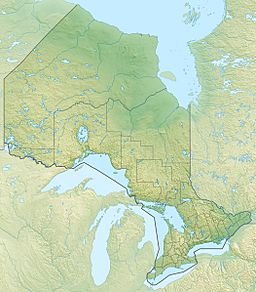McKenzie Lake (Rainy River District) facts for kids
Quick facts for kids McKenzie Lake |
|
|---|---|
| lac McKenzie | |
| Location | Rainy River District, Ontario |
| Coordinates | 48°27′34″N 91°03′18″W / 48.45944°N 91.05500°W |
| Part of | Hudson Bay drainage basin |
| Primary inflows | Ferguson Creek, unnamed creek |
| Primary outflows | unnamed creek |
| Basin countries | Canada |
| Max. length | 10.5 km (6.5 mi) |
| Max. width | 5 km (3.1 mi) |
| Surface elevation | 417 m (1,368 ft) |
McKenzie Lake (also known as French: lac McKenzie in French) is a beautiful lake located in the wild, northwestern part of Ontario, Canada. It's a special place because it lies completely within Quetico Provincial Park, a huge natural area.
This lake is an important part of a massive water system called the Hudson Bay drainage basin. This means that all the water from McKenzie Lake eventually makes its way to Hudson Bay.
Contents
Exploring McKenzie Lake
Where is McKenzie Lake Located?
McKenzie Lake is found in the Rainy River District of Ontario, Canada. This area is mostly undeveloped, making the lake a truly natural spot. It's a key feature within the protected lands of Quetico Provincial Park.
How Water Flows Through McKenzie Lake
Water is always on the move, and McKenzie Lake is no different! It has water flowing into it and out of it.
Water Inflows
The main sources of water flowing into McKenzie Lake are two creeks. One is called Ferguson Creek, which comes from Ferguson Lake in the northwest. Another unnamed creek also brings water into the lake from the northeast.
Water Outflows
The water leaves McKenzie Lake through an unnamed creek at its southwest side. This creek flows into McKenzie Bay, which is part of Kawnipi Lake.
Journey to Hudson Bay
From Kawnipi Lake, the water continues its long journey. It travels through several rivers:
- The Maligne River
- The Namakan River
- The Rainy River
- The Winnipeg River
- The Nelson River
Finally, all this water reaches its ultimate destination: Hudson Bay! This shows how connected all the lakes and rivers are in this huge drainage basin.


